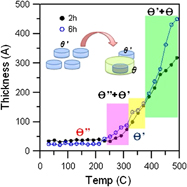Article contents
Resolution of structural transformation of intermediates in Al–Cu alloys during non-isothermal precipitation
Published online by Cambridge University Press: 06 October 2020
Abstract

Morphological evolution and phase transformation of metastable intermediate precipitates are critical to their mechanical properties for the non-isothermal processing. During the non-isothermal precipitation, the formation of the new phases usually couples with structural evolution. Traditional structural characterization has limitation to resolve comprehensive changes simultaneously. In this study, we report direct observation, precipitation sequence, and the details of concurrent morphological and structural changes of various intermediate precipitates during non-isothermal heating in the Al–Cu systems with different pretreatments. The structural heterogeneity during the non-isothermal precipitation processes is resolved into coexistence of two different precipitate phases and quantitatively studied in terms of the phase transition and the morphological evolution. This paper presents the in situ small- and wide-angle synchrotron x-ray scattering (SAXS and WAXS) to refine and to identify the mixed structural information during multiple precipitation stages. The WAXS results show that the precipitation sequence is θ″ → (θ″ + θ′) → θ′ → (θ′ + θ) → θ upon heating. Due to the fact of the specifically oriented SAXS intensity, the evolution of the aforementioned phase transformation is resolved by the refinement of the SAXS intensity integrated over the selected area. These methods reveal multiscale information that is not trivial comparing to the traditional characterization methods.
- Type
- Articles
- Information
- Copyright
- Copyright © Materials Research Society 2014
References
REFERENCES
- 11
- Cited by


